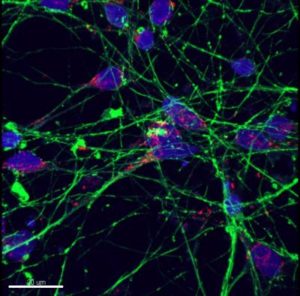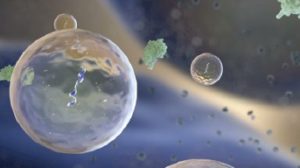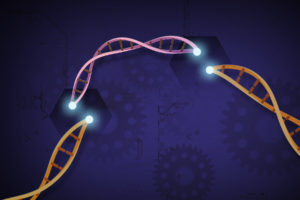CRISPRed Exosomes Correct Rett Syndrome Communication Breakdown
CRISPR continues to be big news.
Condemnation of the gene editing technology was swift late last year when a researcher in China claimed to have used it to doctor the genomes of twin girls to enable them to resist HIV infection.
Agricultural and future medical applications continue to inspire debate, while the idea of gene drives to fuel extinctions of disease vectors, like mosquitoes, raises concern over the danger of tinkering too much with ecosystems.
CRISPR has entered fiction plots, such as last spring’s ridiculous Rampage. The just-axed Netflix reboot of Designated Survivor transformed the acronym into a verb, as in “the bird flu gene was CRISPRed into the virus.” Makes me think of biotech bacon.
Although curing disease, wiping out mosquitoes, and creating fictional bioweapons are exciting prospects, I’m more interested in the harnessing of CRISPR to peek at the origins of disease, in cells. Hollis Cline, PhD, and her colleagues at the Scripps Research Institute have done just that to investigate Rett syndrome, reporting in the Proceedings of the National Academy of Sciences.
A Neurological Syndrome
Rett Syndrome affects 1 in every 10,000-15,000 girls, and very rarely boys. The son of NBC news correspondent Richard Engel is an exception; he has a mild mutation.
The condition typically arises as a new, dominant mutation on the X chromosome in a gene called MECP2. The condition is seen overwhelmingly in girls because the mutation arises nearly all the time in sperm, and boys get their Y from the father, not the X. Monica Coenraads, executive director of the Rett Syndrome Research Trust, explains how Rett originates here.
MECP2 encodes a transcription factor, which is a protein that controls a slew of other genes, so that the one genetic glitch can spark a cascade of effects. When MECP2 is mutant, neuron-to-neuron signaling in the brain goes haywire.
The first sign of Rett syndrome is usually a slowing of development in early toddlerhood, which is common to many conditions, but a telltale sign is a very distinctive holding and wringing of the hands. Children have problems walking, have seizures, and may have intellectual disability. Rett syndrome may also cause autistic behaviors, but is no longer consider to be part of the spectrum due to the single-gene origin and the fact that not all children experience it. Many children with Rett syndrome die young.
Combining Technologies
The new research harnesses the power of two established technologies and recruits a third, to glimpse the molecular mayhem at the crux of Rett syndrome.

The first two approaches, CRISPR/Cas9 gene editing and use of human induced pluripotent stem (iPS) cells to generate specialized cells that are hard to culture, have been around since 2012 and 2007, respectively.
CRISPR/Cas9 removes or replaces specific genes. Human iPS cells are derived from skin fibroblasts, chemically coaxed to lose their specializations and become stem cells, then further guided, using a soup of transcription factors, to yield a desired cell type, such as neurons. Getting nerve cells from iPS cells is valuable because mature neurons don’t divide. Cultures poop out, although neural progenitor and neural stem cells can divide.
The third tool the researchers used was fleets of exosomes. These tiny bubbles normally form from bits of cell membrane and flit about body fluids, ferrying proteins and nucleic acids (RNAs and DNA) from cell to cell and are also distributed more widely through the cerebrospinal fluid.
Exosomes are everywhere. All cells make them and they traverse all body fluids, but they’re particularly important in the brain. “During different stages of brain development, signaling between cells is absolutely essential. We found that exosomes are one of the ways cells communicate these signals,” said Dr. Cline.
CRISPRed Exosomes to the Rescue
The researchers began with neurons created from iPS cells from a child with Rett syndrome. The neurons were sick, with small central cell body areas, few extensions, and a striking inability to connect with each other at synapses, the tiny spaces across which the electrochemical signals of neurotransmission pass.

The Rett neurons jettisoned their exosomes, which the investigators had marked with fluorescent tags. They collected and shattered the exosomes and determined their protein content (a fourth technology, proteomics), finding that the tiny bubbles were missing many proteins normally found in the exosome emissaries from nerve cells. “They did not have bad stuff, but lacked the good stuff,” said lead author Pranav Sharma, PhD, and they were chock full of signaling proteins.
Of the 2,572 types of proteins normally in a neuron’s exosomes, 739 are involved in nerve transmission and 237 are found in vastly different amounts in healthy neurons versus Rett neurons. The MECP2 mutation behind Rett syndrome was putting the brakes on production of many of these proteins.
The researchers corrected the MECP2 mutation using CRISPR/Cas9 in some of the neurons derived from the patient’s iPS cells, while leaving some cells unedited. This was a brilliant strategy, because it provided an “isogenic” set of cells: identical genetically to the patient-derived cells, except for having functioning MECP2 patched in. With the correction courtesy of CRISPR/Cas9, the otherwise deficient exosomes were loaded with the needed proteins. “Fixing the mutation reversed the deficits,” Sharma explains.
Further experiments showed that giving the tinkered exosomes to the patient’s uncorrected cells could “rescue” them by enabling them to produce the needed 237 proteins. The treated sick cells made their synaptic connections.

The results were even more impressive when the researchers looked at neurospheres, which are balls of neural progenitor cells that form spontaneously in culture, looking like little mirror balls. The cells of a neurosphere communicate and synchronize as they fire off nerve impulses. By culturing neurospheres over a tiny electrical grid, the researchers could track the waves of neural connectivity arising among the Rett cells given the CRISPR-corrected exosomes.
Commercialization, of Course
Dr. Cline put the findings in perspective. “Exosomes from healthy cells can indeed rescue neurodevelopmental deficiencies in cells with Rett syndrome. We see this as very promising, because of the many neurodevelopmental disorders in need of a treatment. These are disorders for which we already have a deep understanding of the underlying gene deficiencies but are still lacking a therapy to address the disease itself.”
Next up for the Scripps group: exploring whether exosome activity can be applied to diagnose Rett syndrome earlier or assess potential treatments, and trying the approach with autism spectrum disorders and neurodevelopmental diseases such as fragile X syndrome. Exosome irregularities have also been implicated in Parkinson’s disease, glioblastoma, and schizophrenia.
Pharmaceutical companies are of course drooling over the possibility of, as one company put it, “harness(ing) the power of nature’s cellular messaging system to pioneer a new class of biologic medicines.” Exosomes are easy to nurture and scale up in the laboratory, and we can control what’s in and on them.
And so the companies have been popping up over the last few years.
Exosome Diagnostics (acquired by Bio-Techne in 2018) has adapted exosomes as the workhorse of liquid biopsy tests, which spot tumor DNA in body fluids, like blood or urine. The company’s ExoDx® Prostate (IntelliScore) (EPI) test detects 3 RNA biomarkers in exosomes in urine from men who have elevated PSA levels, helping to identify individuals who should go on for an initial biopsy.
Offerings on the therapeutic front are a little more vague. Codiak Biosciences. founded by researchers from the University of Texas and MD Anderson, is exploring using exosomes to tackle “a diverse array of diseases that are currently difficult or impossible to treat,” under the categories of infectious disease, immune-oncology, vaccines, and autoimmune inflammatory. That covers a lot.
Evox Therapeutics, started by folks from Oxford University and the Karolinska Institute, are tackling “a broad range of severe diseases,” but single out a specific target for preclinical work, Duchenne muscular dystrophy. That makes sense, because the protein that’s missing in affected boys, dystrophin, is so huge that it must be whittled down for delivery in gene therapy strategies.
Finally, ExCoBio, a Korean company, offers a vibrant website with disappearing text like a Star Wars movie intro and a regal blue double helix backdrop when you click “Mission.” Then “Cosmeceuticals” appears in large print, but I couldn’t find any other info. But that’s a heads-up to be on the lookout for “exosome” festooning skin care products soon, like the overuse of “microbiome” emblazoned on the likes of sunscreens and make-up that I wrote about last week.
Perhaps we’ll even see CRISPRed anti-mosquito bug spray.
(Thanks to the International Rett Syndrome Foundations for providing the opening photo)


Vascular eds type 4
Will scientists get to using this method to replace or repair the mutation involved ?
Concerned gr parent of three who have vascular eds.
Hi David. The exosomes are just the vehicle, like viruses used in gene therapy or gene editing. But they might be safer than using viruses, which I suspect explains the company interest.
Hola, entiendo que es muy difícil predecir los resultados, pero me interesa muy especialmente saber si se considera que podría ser reversible ya en la edad adulta el Síndrome de Rett o solo en la infancia, teniendo en cuenta por supuesto el nivel de cuidado y conservación de la persona.
Y además para cuando se espera o calcula que podría surgir una terapia efectiva de reversión? Y hasta qué grado?
Muchas gracias
Reversal in a person would require delivering the CRISPRed exosomes to the cells that need them in the brain, which would be very difficult to target. These studies in human cells growing in culture can reveal how a disease starts and proceeds, but moving to the whole-body level introduces a set of very high hurdles. But, understanding pathogenesis is a start!
Do we have any hope to receive a cure for our children suffering from Rett syndrome and fragile x in near future ?
Sorry in the delay, I was away. Until geneticists and molecular biologists can invent targeted treatments, it is good to focus on the therapies that make life easier for the child on a day to day basis — which you must already be doing. Self-esteem, activities of daily living, working on development milestones, those are vitally important. Gene therapies are difficult because they must target the correct cells in a many-celled body. Good luck to you!